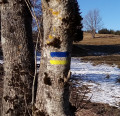Equipment:
Bring the usual equipment for long-distance hikes, while taking care not to overload your backpack. Items which to me seem essential for the WHW:
- Waterproof hiking shoes.
Rain protection: rain cape, backpack protection, etc.
- Clothing to protect against the cold and/or wind.
- Midge repellent, can be bought locally.
- An electrical outlet adapter for the United Kingdom (in particular to be able to recharge your phone battery).
NB There are companies on site that organise luggage transportation from point to point, which allows you to hike with a small bag during the day and keep the rest dry.
Signage:
- The route is very well marked on site, mainly at major intersections and changes of direction, by three complementary means: sign posts with thistle flower; posts with a yellow arrow for changes of direction; signposts.
- Having the route instructions on your phone via the Visorando application is an undeniable plus. Remember to save the basemaps (OSM Hiking) of all stages before departure. This will allow you to precisely follow progress on a map regardless of the quality of your network connection and even in the absence of a network.
- Physical maps on a British map background (pdf file of each stage) are a back-up.
- A compass does not weigh very much and can very useful.
Water:
It is best to fill your water containers from the tap at your accommodation. There are no real water refilling points along the way. Admittedly, there are countless streams and torrents on the course but the potability of this water is not guaranteed (bring water purification tablets if you plan to use these).
In some places, especially along the first two stages, locals will provide bottles of water or other drinks at the side of the route which should be paid for by putting the amount indicated in an Honesty Box (the system is based on trust).
Supplies:
Details of opportunities to resupply are mentioned in the sheets for each stage.
- Shops: Glasgow; Milngavie; Drymen; Inverarnan (sundry supplies); Tyndrum; Kinlochleven; Fort William.
- Cash machines: Glasgow; Milngavie; Kinlochleven; Fort William.
- Some hotels offer packed lunches to order the day before for the next day’s trek.
Accommodation:
Hotel type accommodation (with bar-restaurant) or Bed and Breakfast are recommended, being more or less numerous depending on the stage. These suggestions do not claim to be exhaustive: for more addresses, use your preferred search engine. Remember to book well in advance.
Camping:
Many hikers follow the WHW while camping (bring a really waterproof tent). On the route, the camping is highly regulated, with official campsites, places where camping is allowed (for example near a hotel) and several sites where it is strictly prohibited. Inquire beforehand and respect the indications found on site. And remember to take your refuse with you to the next village.
Recommendations:
- The WHW crosses sensitive areas, nature reserves and national parks. Do not leave any refuse on site! Take everything with you to the next village.
- The moors and pastures of the highlands are grazed by (Scottish Blackface) sheep and, to a lesser extent, (Highland Cattle and Aberdeen Angus breeds) of cattle. The route therefore crosses many fields and hikers must open and close countless barriers: these are generally equipped with an automatic closing system, but it is considered responsible to check it has closed properly after passing through.
Breakdown of stages:
7-day trek - This is what is offered here and represents an average of 22km and 400m of elevation gain per day. As this is already a long daily distance, and a non-negligible elevation, that the whole route is classified as Difficult, even though the course itself does not involve any technical difficulty.
NB The longest stage (30.4km), from Inverarnan to Bridge of Orchy, can be reduced to 20km if you complete your last section by public transport. See the indications in the "Practical information" section of the corresponding hiking guide.
The 8-day trek - represents an average of 19.5km and 360m of elevation gain per day. Depending on the accommodation available, the route can be broken down as follows: Milngavie - Drymen - Rowardennan - Inverarnan - Tyndrum - Inveroran - Kingshouse Hotel - Kinlochleven - Fort William.
6-day trek (an average of 26km and 480m of elevation gain per day) or a 5-day trek (average of 31km and 575m of elevation gain per day) - Requires excellent physical condition and proven endurance.
In any event, plan a route in line with your own capabilities.
Useful links:
- Official site of West Highland Way.
- Trains: ScotRail website ScotRail.
- Bus: Citylink website Citylink.
'’Hiked by the author in August 2019.''




















